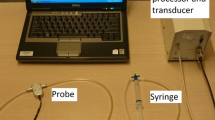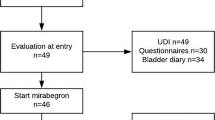Abstract
Introduction and hypothesis
The aim was to evaluate, using urethral pressure reflectometry (UPR), the effect of fesoterodine on urethral function in women with stress urinary incontinence (SUI).
Methods
Women aged 18 to 65 years were eligible for this randomised, double-blind, placebo-controlled, crossover study if they had had clinically significant SUI or SUI-predominant mixed urinary incontinence for >3 months. Each participant received fesoterodine 4 mg, fesoterodine 8 mg, and placebo once daily for 7 days, with a 7- to 10-day washout between treatments. UPR was performed at baseline and 4 to 8 h after the last dose in each treatment period. Participants completed a 3-day bladder diary before randomisation and during the last 3 days of each treatment period.
Results
Of the 22 women randomly assigned and treated, 17 met the criteria for the primary efficacy analyses. No statistically significant differences were seen between fesoterodine 4 mg or fesoterodine 8 mg and placebo in opening urethral pressure (primary endpoint) or other UPR endpoints. No statistically significant differences were seen between either fesoterodine dose and placebo in the change from baseline in the bladder diary variables (total urinary incontinence, SUI, or urgency urinary incontinence episodes per 24 h). Adverse events were reported by 8 participants taking fesoterodine 4 mg, 17 taking fesoterodine 8 mg, and 8 taking placebo.
Conclusions
Fesoterodine did not affect urethral pressure or significantly decrease the number of incontinence episodes in women with SUI. The UPR parameters showed no placebo effect, while there was a placebo effect of 60 % based on the bladder diary.


Similar content being viewed by others
Abbreviations
- SUI:
-
Stress urinary incontinence
- UPP:
-
Urethral pressure profilometry
- UPR:
-
Urethral pressure reflectometry
- UUI:
-
Urgency urinary incontinence
References
Hunskaar S, Lose G, Sykes D, Voss S (2004) The prevalence of urinary incontinence in women in four European countries. BJU Int 93(3):324–330
Milsom I (2009) Lower urinary tract symptoms in women. Curr Opin Urol 19(4):337–341
Deng DY (2011) Urinary incontinence in women. Med Clin N Am 95(1):101–109
Rovner ES, Wein AJ (2004) Treatment options for stress urinary incontinence. Rev Urol 6 [Suppl 3]:S29–S47
Wang A, Carr LK (2008) Female stress urinary incontinence. Can J Urol 15 [Suppl 1]:37–43, discussion
Weir M, Brien J (2000) Adolescent urinary tract infections. Adolesc Med 11(2):293–313
Klarskov N, Lose G (2007) Urethral pressure reflectometry; a novel technique for simultaneous recording of pressure and cross-sectional area in the female urethra. Neurourol Urodyn 26(2):254–261
Klarskov N, Lose G (2007) Urethral pressure reflectometry vs urethral pressure profilometry in women: a comparative study of reproducibility and accuracy. BJU Int 100(2):351–356
Klarskov N, Scholfield D, Soma K, Darekar A, Mills I, Lose G (2009) Measurement of urethral closure function in women with stress urinary incontinence. J Urol 181(6):2628–2633, discussion 33
Anderson KE (2011) Muscarinic acetylcholine receptors in the urinary tract. In: Anderson KE, Michel MC (eds) Urinary tract, handbook of experimental pharmacology. Springer, Berlin, pp 327–328
Abrams P, Cardozo L, Fall M, Griffiths D, Rosier P, Ulmsten U et al (2002) The standardisation of terminology of lower urinary tract function: report from the Standardisation Sub-committee of the International Continence Society. Neurourol Urodyn 21(2):167–178
Abrams P, Andersson KE (2007) Muscarinic receptor antagonists for overactive bladder. BJU Int 100(5):987–1006
Wein AJ (2001) Pharmacological agents for the treatment of urinary incontinence due to overactive bladder. Expert Opin Investig Drugs 10(1):65–83
Andersson KE, Pehrson R (2003) CNS involvement in overactive bladder: pathophysiology and opportunities for pharmacological intervention. Drugs 63(23):2595–2611
Nitti VW, Dmochowski R, Sand PK, Forst HT, Haag-Molkenteller C, Massow U et al (2007) Efficacy, safety and tolerability of fesoterodine for overactive bladder syndrome. J Urol 178(6):2488–2494
Chapple C, Van Kerrebroeck P, Tubaro A, Haag-Molkenteller C, Forst HT, Massow U et al (2007) Clinical efficacy, safety, and tolerability of once-daily fesoterodine in subjects with overactive bladder. Eur Urol 52(4):1204–1212
Acknowledgements
Funding for this study was provided by Pfizer Inc. Editorial assistance was provided by Karen L. Zimmermann and Colin P. Mitchell, PhD, of Complete Healthcare Communications, Inc., and was funded by Pfizer Inc.
Financial disclaimers/conflicts of interest
The study was funded by Pfizer Inc. AD, DS and LW are employees of Pfizer Inc.
Author information
Authors and Affiliations
Corresponding author
Rights and permissions
About this article
Cite this article
Klarskov, N., Darekar, A., Scholfield, D. et al. Effect of fesoterodine on urethral closure function in women with stress urinary incontinence assessed by urethral pressure reflectometry. Int Urogynecol J 25, 755–760 (2014). https://doi.org/10.1007/s00192-013-2269-6
Received:
Accepted:
Published:
Issue Date:
DOI: https://doi.org/10.1007/s00192-013-2269-6




